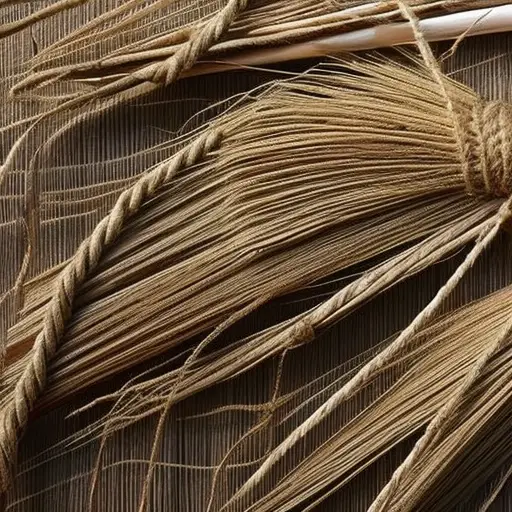DIY Techniques for Making Natural Rope and Cordage

Did you know that natural rope and cordage can be made using simple DIY techniques?
In this informative article, we will explore the process of gathering and preparing plant fibers, as well as utilizing animal sinew for cordage.
We will also delve into the art of twisting and braiding techniques, and how to add strength and durability with knots and splices.
Discover the practical applications and benefits of creating your own natural rope and cordage.
Gathering Natural Materials
When gathering natural materials for making rope and cordage, it is essential to carefully select and harvest plants that possess strong and flexible fibers. There are various foraging techniques that can be employed to identify and collect suitable natural fiber sources.
One of the most effective methods is to research and familiarize oneself with the local flora, specifically the plants that have traditionally been used for making rope. This knowledge will help in identifying plants with long, fibrous stems or leaves that can be utilized for cordage production.
In addition to studying plant species, it is important to consider the season and stage of growth when foraging for natural fibers. Plants tend to have stronger fibers during certain periods, such as when they are in their reproductive stage or when the stems have matured but are not yet woody. It is also crucial to gather fibers from healthy plants, avoiding those that show signs of disease or damage.
Preparing and Processing Plant Fibers
After carefully gathering natural materials with strong and flexible fibers, the next step in making natural rope and cordage is to prepare and process the plant fibers for use. Plant fibers come in various types, such as hemp, flax, jute, and sisal. Each type has its own characteristics and suitability for rope making.
To prepare the plant fibers, they need to be cleaned and stripped of any unwanted material. This can be done by removing leaves, bark, and any other debris. The fibers can then be soaked in water to make them more pliable and easier to work with. After soaking, the fibers are ready for the next step.
Traditional rope making techniques involve twisting and braiding the prepared plant fibers together. This can be done by hand or using simple tools such as a spindle or a rope making machine. The fibers are twisted in a specific pattern to create a strong and durable rope. The number of strands and the tightness of the twist can be adjusted depending on the desired thickness and strength of the rope.
It is important to note that the quality of the rope depends on the quality of the plant fibers and the skill of the rope maker. Careful preparation and processing of the plant fibers is essential to ensure a successful outcome.
Twisting and Braiding Techniques
To create strong and durable natural rope and cordage, twisting and braiding techniques are utilized. These techniques allow for the manipulation of different fibers and materials to create a variety of ropes and cords with varying thicknesses and strengths. Here are three important aspects to consider when using twisting and braiding techniques:
-
Twisting variations: Twisting is the process of combining multiple strands of fibers by twisting them together. There are different variations of twisting, such as S-twist and Z-twist. The S-twist involves twisting the fibers in a counterclockwise direction, while the Z-twist involves twisting them in a clockwise direction. By alternating between these two twists, you can create a more balanced and durable rope.
-
Braiding patterns: Braiding involves intertwining multiple strands of fibers to create a stronger cord. There are various braiding patterns to choose from, including simple braids, cobra braids, and diamond braids. Each pattern offers different levels of complexity and strength. Experimenting with different braiding patterns can help you create cords with unique textures and designs.
-
Combination techniques: You can also combine twisting and braiding techniques to create more complex cords. For example, you can twist individual strands and then braid them together to create a stronger rope. This combination of techniques allows for increased strength and durability.
By mastering these twisting and braiding techniques, you can create natural ropes and cords that meet your specific needs.
Now, let’s explore another method for making cordage – utilizing animal sinew.
Utilizing Animal Sinew for Cordage
Animal sinew can be effectively utilized for creating strong and durable cordage. Sinew, which is the tough fibrous tissue found in the tendons of animals, has been used for centuries by indigenous people around the world for making ropes and cords. It is a natural material that is strong and flexible, making it ideal for various applications.
To utilize animal sinew for cordage, start by sourcing tendons from animals such as deer, bison, or elk. These tendons can be obtained from hunting, but it is important to ensure that the animal was harvested legally and ethically. Once you have obtained the tendons, they need to be processed to remove any excess flesh and fat. This can be done by scraping or peeling the tendons with a knife.
After the tendons have been cleaned, they can be split into thinner strands by carefully pulling them apart. These strands can then be twisted or braided together to create a strong and durable cord. The resulting cordage can be used for various purposes, such as making traps, fishing lines, or even for securing items in a survival situation.
While animal sinew is a traditional and effective material for cordage, it may not always be readily available or suitable for everyone. In such cases, there are alternative materials that can be used, such as plant fibers like hemp or nettle, or even synthetic materials like paracord. It is important to consider the specific needs and resources available when choosing the material for cordage.
Adding Strength and Durability With Knots and Splices
When it comes to adding strength and durability to natural rope and cordage, there are two key techniques to consider: knot variations and splicing.
Knot variations, such as the square knot or the bowline, can be used to secure the ends of the rope or join two ropes together, providing additional strength.
On the other hand, splicing involves weaving the rope strands together, creating a seamless and durable bond that is less prone to unraveling or weakening.
Knot Variations for Strength
Knot variations can significantly enhance the strength and durability of natural rope and cordage. Different types of knots can be used for specific purposes, providing added strength and security in various situations.
Here are three techniques for increasing the strength of knots:
-
Double knot: By tying a knot twice, you create a more secure and stable connection. This is particularly useful when tying two ropes together or securing a knot that will be under tension.
-
Clove hitch: This knot is known for its ability to grip tightly around an object, making it ideal for securing a rope to a post or pole. Its simple yet effective design provides a strong hold that can withstand pulling forces.
-
Figure-eight knot: This knot is commonly used to prevent the end of a rope from slipping through an opening. Its tight and compact structure adds strength and prevents unraveling.
By utilizing these knot variations, you can enhance the strength and durability of your natural rope and cordage.
Now let’s explore splicing techniques for even greater durability.
Splicing Techniques for Durability
To enhance the strength and durability of natural rope and cordage, one effective technique is to incorporate splicing methods, which add strength and durability through the use of knots and splices.
Different rope types require specific splicing techniques to ensure optimal performance. For example, braided ropes can be spliced using the ‘eye splice’ method, where the rope is folded back on itself to create a loop, and then a series of tucks and locks are made to secure the splice. On the other hand, twisted ropes may benefit from ‘back splice’ or ‘end splice’ techniques, where the strands are unravelled and interwoven to create a secure splice.
For heavy-duty applications, such as in marine or industrial settings, more complex splicing techniques like the ‘double braid splice’ or ‘long splice’ can be employed to provide maximum strength and durability. These techniques involve weaving and interlocking the rope strands to create a splice that is nearly as strong as the original rope.
By mastering these splicing techniques, DIY enthusiasts can significantly increase the strength and durability of their homemade rope and cordage.
Transition: Now that we have covered splicing techniques for durability, let’s explore the practical applications for DIY rope and cordage.
Practical Applications for DIY Rope and Cordage
DIY rope and cordage offer versatile uses in a variety of practical applications. From camping and survival situations to gardening and home improvement projects, having homemade rope and cordage can be invaluable.
Additionally, DIY rope and cordage can be used creatively in arts and crafts projects, providing a unique and natural touch to handmade items.
Versatile Uses for Cordage
Utilizing cordage in various practical applications offers a multitude of benefits for DIY enthusiasts seeking versatile solutions. Cordage can be used in innovative ways that not only serve a purpose but also provide eco-friendly alternatives to traditional materials. Here are three versatile uses for cordage:
-
Gardening: Cordage can be used to create trellises, plant supports, and even hanging planters. Its strength and durability make it ideal for supporting the weight of plants and vegetables, while its natural material blends seamlessly into the garden environment.
-
Camping and outdoor activities: Cordage is an essential tool for any camper or outdoor enthusiast. It can be used for setting up tents, creating clotheslines, securing gear, and even crafting makeshift hammocks. Its versatility and strength make it a reliable and eco-friendly alternative to plastic or synthetic ropes.
-
Crafts and DIY projects: Cordage can be a valuable resource for various crafts and DIY projects. It can be used for making jewelry, weaving mats or baskets, creating decorative elements, and even building furniture. Its natural texture and appearance add a rustic charm to any project, while also minimizing the use of synthetic materials.
Practical Applications of Rope
Cordage finds practical applications in a wide range of DIY projects and can be utilized in various ways to meet the needs of DIY enthusiasts.
One of the most common practical uses of rope is in outdoor adventures. Whether you are camping, hiking, or climbing, having a reliable rope can be essential for safety and functionality. Ropes can be used for securing tents and tarps, creating makeshift clotheslines, or even building shelters.
Additionally, rope can be used in boating and fishing activities, such as tying knots, creating anchor lines, or setting up traps. In emergency situations, rope can be used for first aid purposes, such as creating splints or tourniquets.
With its versatility and strength, rope is a valuable tool for any DIY enthusiast engaging in outdoor activities.
Creative DIY Projects
Rope and cordage have a multitude of practical applications in creative DIY projects, frequently used for their strength and versatility. Whether you’re into DIY crafts or upcycling projects, incorporating rope and cordage can add a unique touch to your creations.
Here are three practical ways you can use DIY rope and cordage in your projects:
-
Macramé Wall Hangings: Create stunning wall art by knotting and weaving rope and cordage into intricate patterns. Macramé wall hangings add texture and visual interest to any room.
-
Plant Hangers: Bring a touch of nature indoors by making plant hangers using rope and cordage. These stylish hangers not only elevate your plants but also add a boho-chic vibe to your space.
-
Hammocks and Swings: Transform your backyard or patio into a cozy retreat by making your own hammocks or swings using strong ropes and cords. Enjoy lazy afternoons lounging in your handmade creation.
With a little creativity and some basic DIY skills, you can turn rope and cordage into beautiful and functional pieces for your home and garden.
Frequently Asked Questions
Can Synthetic Materials Be Used Instead of Natural Materials for Making Rope and Cordage?
Synthetic alternatives can be used instead of natural materials for making rope and cordage. However, it is important to consider the environmental impact of synthetic materials, as they are often derived from non-renewable resources and can contribute to pollution.
Are There Any Safety Precautions to Consider When Gathering Natural Materials for Rope Making?
When gathering natural materials for rope making, it is important to consider safety precautions. This includes identifying poisonous plants and wearing protective gear. Proper techniques for processing plant fibers will also ensure the quality of the rope.
How Long Does It Take for Plant Fibers to Dry and Be Ready for Processing?
The processing time for plant fibers to dry and be ready for processing varies depending on the specific type of plant and the techniques used. Proper drying techniques are crucial to ensure the fibers are fully dried and ready for further processing.
Can Animal Sinew Be Used Interchangeably With Plant Fibers for Cordage Making?
While animal sinew can be used interchangeably with plant fibers for cordage making, it is important to consider the cultural significance of animal sinew in this practice. Both materials have their unique properties and applications, depending on the project’s requirements.
What Are Some Alternative Uses for DIY Rope and Cordage, Besides Practical Applications?
Creative crafts and decorative projects offer alternative uses for DIY rope and cordage, beyond practical applications. These versatile materials can be utilized in macrame wall hangings, woven baskets, jewelry making, and even as accents in home decor, adding a touch of natural beauty.
Conclusion
In conclusion, learning how to make natural rope and cordage using DIY techniques can be a valuable skill for outdoor enthusiasts, survivalists, and those interested in traditional crafting methods.
By gathering and processing plant fibers, utilizing animal sinew, and incorporating knots and splices for added strength, individuals can create durable and versatile cordage for various practical applications.
By mastering these techniques, one can become more self-reliant and resourceful in the wilderness.





